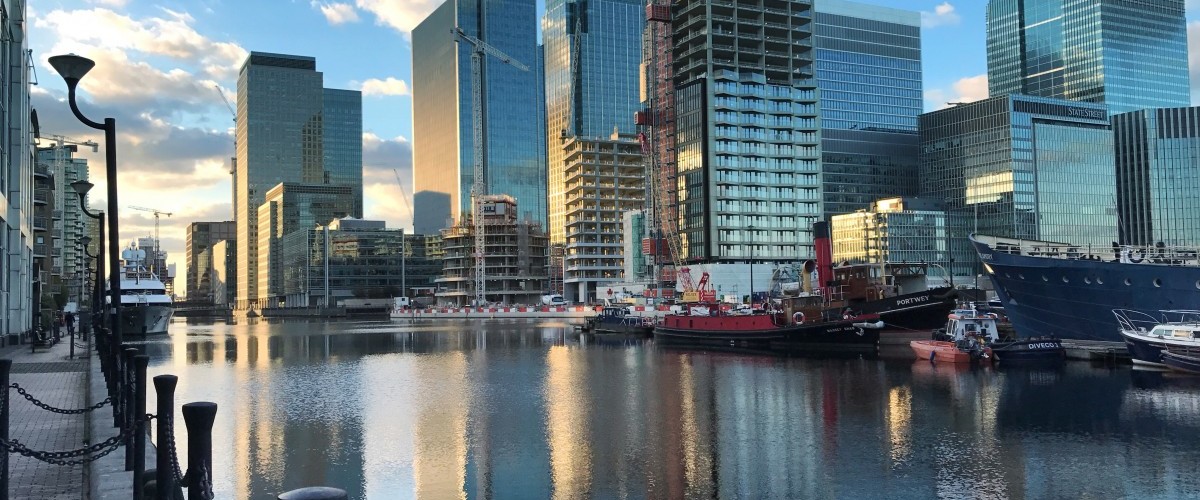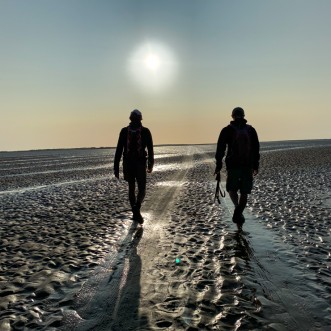“I’ve been walking about London for the last thirty years, and I find something fresh in it every day.” Walter Besant, 1901
So have I but I never realised that there was an island circumnavigation to be had. With the winter approaching and muddy paths and dark evenings to look forward to the lure of the bright lights of the city pull strong.
Here’s a fascinating walk around the Isle of Dog, the big curve in the Thames that will be instantly recognised by Eastenders fans in its opening scene.
Once the bogs of Stepney Marsh, drained by the Dutch, connected to the rest of the world through its docks and now one of the most important financial districts in Europe its fascinating history can be unearthed through a walk around its outer edge.
With plenty of green space and many iconic riverscapes including Greenwich to the south, often considered one of the most famous views in London, this walk will entertain the whole family with plenty of great pit stops along the way.
Starting at the Canary Wharf River Bus stop and walking east along the Thames Path the Isle of Dogs proper is reached via the metal footbridge to Limehouse Lock over the remnants of The City Canal, built as a short cut for vessels travelling to wharves further up the Thames.
Here you get your first taste of the scale of the new building activity on the Isle. The developing jungle of multi-colour high rise skeletons rise out of the old docks to the constant clatter of haulage equipment straining to get thousands of tonnes of cement to its sky high destination.
Just a few metres away though this is sharply contrasted by the calm waters of the Thames gracefully meandering towards the sea, host to diving grebes and squabbling gulls and offering nature’s peace to the inhabitants of this frenetic urban forest.
After a kilometre or so of walking through the colourful residential areas strung along the river the Sir John McDougal Gardens offer the first play space for kids and a picnic spot. Historically built to allow public access to the river, when huge flour mills dominated the foreshore, it was designed to make the most of the expansive views of the Thames. Oh the thoughtfulness of the flour milling McDougal family.
Continuing along the Thames path a short but interesting detour inland from the river along Westferry Road passes the Docklands Sailing Centre with its historical twin cranes and on to the curious façade of St Paul’s. Known as The Space, this is one of London’s most important buildings. Built for the Scottish Presbyterian dockers it is now a centre for the performing arts with a café bar, The Hubub, serving good food and coffee.
After a breakfast pit stop at the Hubub and passing through the arches of a small residential area, the return to the calm of the river is welcome. Here Millwall is an area probably better known for its football club than the flour mills that were built along the walls of the Thames.
This area is also the site that the SS Great Eastern, the largest ship of its time, was launched sideways into the Thames. A section of the launch site is preserved at the modern Napier Avenue. Today with the planes roaring overhead on their final approach to Heathrow it’s hard to imagine what travel was like in the 1800s.
Slightly further along is Burrells Wharf, once an important trading centre for chemicals, paints, drugs and oils and now a smart residential complex. The brick chimney used by the colourmakers often belched out pink smoke that left the local pigeons with pink tinted feathers. The pigeon-racing locals saw a pink pigeon as a lucky pigeon, though maybe the opposite was true if it had inhaled the toxic fumes from this industry.
A few steps on and it’s well worth pausing to pick out the famous landmarks across the river at Greenwich – the glass dome at the south entrance of the foot tunnel, the wooden masts of the Cutty Sark, the majestic buildings of Greenwich Hospital and the parkland with the Royal Observatory on the hill top all contribute to one of the most famous views of London.
Historically, at this point of the river, there really couldn’t have been a greater difference between the two landscapes either side of the Thames.
Despite those differences the connection between the Isle of Dogs and Greenwich has always been strong. The best modern day evidence of this the very good Ferry House Inn. The oldest building on the island and close to the old ferry crossing to Greenwich it’s easy to imagine it catering for the men that regularly crossed the river between the two points to graze and fatten up their horses and cattle on the pastures of the Isle.
A short distance on and the Island Gardens provide a lovely green space, a strong sense of community and the northern access point to the Greenwich tunnel – a mighty engineering feat for its time and Victorian architectural delight if you decide to walk through it. The Gardens, built so that the views from Greenwich across to the Isle of Dogs were easy on the eye, are another pointer to world of the ‘haves’ and ‘have nots’ of history.
Although there is an outdoor café here we were tempted to explore Mudshute Park and Farm, just north of Island Gardens and the largest city farm in Europe with thirteen hectares of open space, a medley of farm animals and café. Clues to the origins of the site can be interpreted in its name; the overspill from excavating Millwall Dock was dumped here through a chute system.
After the gardens the Thames path rounds the southern tip of the island and continues north past the rather uninspiring Great Eastern Pub. On the south side of the Thames the skyline is dominated by the yellow-strutted O2 Centre and the helter-skelter of the Emirates Air Line cable car spanning the river between Greenwich in the south and the Royal Docks in the north.
The river traffic eases off on this stretch of the Thames. Just the superfast Clipper boats that skim the surface of the water and the river barges on their way to recycling what the City doesn’t need. There is a lot more bird life here and, if you are lucky, you may see seals and maybe even a porpoise.
Rounding off the northern leg of the island there are a couple of diversions inland to avoid housing estates and building projects before the brightly coloured pagoda-like building of Outrums pumping station makes for quite a surprise as you rejoin the river. Grade II listed this is the first listing to come out of Historic England’s Post-Modernism project. Don’t be deceived by its unusual design though it’s a workhorse during periods of heavy or prolonged rain when the main sewer network fills up and pumps excess water directly to the River Thames to prevent flooding.
Time to turn west. Reaching the eastern end of the old City Canal and crossing the road to South Quay makes for an abrupt reintroduction to the island’s modern history. Canary Wharf’s towering, angular buildings with their colourful and reflective surfaces oozes financial success and the ultimate in urbanisation. You’ll find fishermen on the dockside as you walk the length of the South Dock though so nature still has her hold.
The walk is completed by crossing Marsh Road and rejoining the tideway at Lime House Lock. With tired legs, rosy cheeks and a head full of history you’ll definitely have a fresh perspective on a part of London that is often missed off the average tourist’s itinerary.
You’ve only just scratched the surface though. There’s plenty more to explore.
Getting there: River Bus stop at Canary Wharf; Dockland Light Railway to Canary Wharf; Buses – D3 Bethnal Green to Canary Wharf; D7 Mile End to Canary Wharf; D8 Stratford to Canary Wharf; 135 Moorfields to Canary Wharf; 277 Highbury and Islington to Canary Wharf; N550 Trafalgar Square to Canary Wharf (Night Bus).



Your site has exceptional content. I bookmarked
the site
This is really helpful, thanks.
Thanks for the excellent manual
Thanks for the terrific guide
Thanks, it’s quite informative